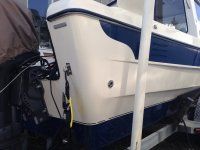Glad that worked for you :thup And it will last (store) for years, too, which is handy. I mean, it doesn't "go off" or anything in storage.
One caveat is that butyl will not stand up to fuel soaking (it will dissolve). As a result, I used polysulfide to bed the fuel fills. Also, as I mentioned above, butyl is not an "adhesive." So anything bedded with it should also be mechanically fastened (but then most things tend to be). There is a white plastic fitting just below the cabin door on my 22 that I replaced/re-bedded that is a wee bit shy on fastening, due to the shape. For that I used 3M4000, since it's adhesive, white, and is not supposed to yellow in UV. I also used 3M4000 on the new fasteners on the rubrail, because in that case I wanted something that would cure (whereas most times I want something that will stay more pliable). Anyway, just mentioning it in case I sound like a butyl freak :lol:
Another note is that officially, it's not for use below the waterline. That said, I read a post from a fellow who worked as some sort of marine researcher, and they had, IIRC, underwater cameras in clear domes that had a seam around the "equator." They butyl-ed the seams closed, then some weeks/months later, retrieved them and the butyl apparently held up. Since reading that, and because I like experiments, I have bedded a few things below the waterline with butyl. Nothing critical (since I'm not yet sure how it will perform), but in a few places that wouldn't cause a problem if it failed because they really didn't need it. Guess I'll find out in a few years what happens, but in the meantime, just know it's for above the waterline (i.e. places that are not constantly submerged).
(One of the experiments is to use it on Starboard, which normally rejects bedding/sealants. I put some on my transducer block to see what would happen over time.)
Mineral spirits works well to prep for, and clean up after, butyl. Also you can often make a little roll with leftover scraps, and poke any bulge out with it and remove it.
There is a nice tutorial on working with butyl tape on Compass Marine's site (not that it's so different than other bedding compounds, but who doesn't like to read a good photo tutorial? Plus, I find I can always pick up a few tips, even on something I've already been doing.
http://www.pbase.com/mainecruising/rebedding_hardware
